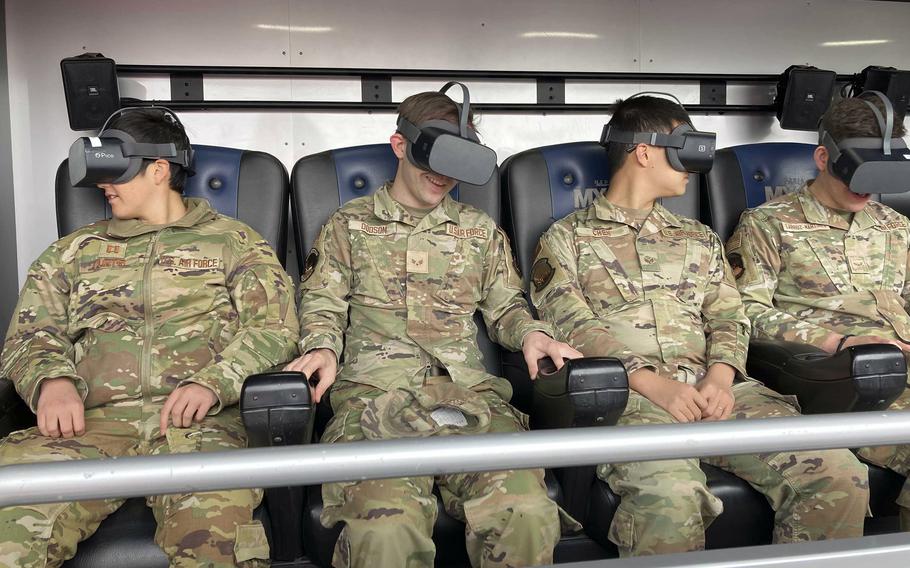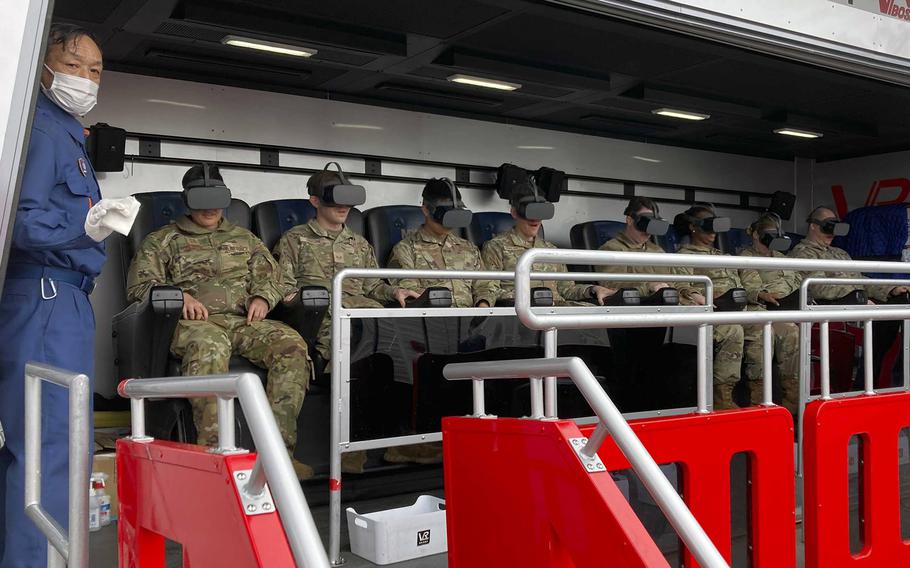
Airmen wear virtual reality goggles during the simulation of a major earthquake at Yokota Air Base, Japan, March 28, 2024. (Juan King/Stars and Stripes)
YOKOTA AIR BASE, Japan — Earthquakes are routine, unscheduled events in Japan, and an annual safety fair at this airlift hub in western Tokyo aims to prepare new arrivals for that eventuality.
To get a taste of what a major quake feels like, airmen, eight at a time, donned virtual reality goggles aboard a simulator during the March 28 event outside the Yokota Community Center.
The VR experience gave them a first-person view of the events before, during and after an earthquake, eliciting a range of reactions, from stern expressions to laughter. Onlookers got a taste of the action, too, via a large screen attached to the simulator.
“It was a pretty cool and very real experience,” said Senior Airman Kaitlin Cerda, a mental health technician for the 374th Medical Group. “I feel like it prepared me more to set up my house more for earthquakes.”
Days later, a 7.4-magnitude quake on Taiwan served as a reminder that a deadly temblor can strike the region at any time. At least nine people were killed and more than 1,000 were injured. It spurred tsunami alerts and mandatory evacuations at U.S. bases on Okinawa.
On Jan. 1, a 7.6-magnitude quake off Japan’s Noto Peninsula, about 175 miles from Yokota, killed more than 200 people and left thousands homeless.

Airmen wear virtual reality goggles during the simulation of a major earthquake at Yokota Air Base, Japan, March 28, 2024. (Juan King/Stars and Stripes)
A second earthquake simulator at the base safety fair placed people inside a mock dining room that shook violently for several minutes. They huddled beneath a table to avoid objects that could fall in an actual earthquake.
Nearby, yet another simulator allowed people to practice escaping from a burning home filled with smoke.
“What we are hoping for is risk management awareness, as well as getting a firsthand experience to what some of these emergencies might actually look like,” Maj. Nick Reed, the 374th Airlift Wing’s chief safety officer, said at the event.
“They help better prepare service members in case something does happen and help save their lives.”
Earthquakes weren’t the fair’s only focus. A car-crash simulator catapulted riders forward to illustrate the importance of wearing seatbelts. During a motorcycle safety exhibition, several Air Force and Japanese police riders demonstrated the skills required to maneuver powerful two-wheelers around potential hazards.
Approximately 200 people, including safety teams from Yokota and off-base Japanese agencies, turned out for the five-hour fair.
“We are glad to see a lot of people are interested in safety,” said Fussa traffic safety officer Samizo Masakazu.